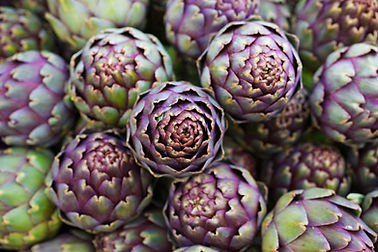
Other vegetables
These are the plants that didn't quite make it in to the other categories, even if they are in a plant family to any above. The way they are used makes them usable in different ways. For example artichokes are related to sunflowers and lettuce but they are used in different ways. Lettuce is grown for its leaves, sunflowers for seeds and petals and artichoke for the head
Amaranth


Amaranth is quite often used to add colour and texture to gardens with its large dark green leaves and reddish stems and catkin like seed spikes. Amaranth can be used for the grain it produces and the leaves, which are similar to spinach, can also be eaten without cooking them.
Red or purple amaranth seeds are very small, too tiny for a seed dispenser or to ensure a correct distance when planting. Commonly seeds will be scattered over finely prepared soil, undercover or cloches from March or outside from May. It will be ready to harvest from September - October. Despite being quite a hardy plant it will likely die over winter, but an advantage of amaranth is that it can self-seed (disperses its own seeds).
It well in most soil types, with an expection of overly rich soil, requiring plenty of water. Place in full sun 30-45 cm (12 - 18 inches) apart when planting out. The typical pests are aphids and weevils. For tips on pests new posts and videos.
Artichoke
Artichokes are another plant that enjoys full sun. Sow indoors from March planting out in April - May. Alternatively sow direct in to soil from late April. As these plants can bush out, sow 30 - 60 cm (12 - 24 inches) apart to give them space.
Artichoke should start to be harvest ready from late June - September when the buds/heads reach around 5 cm (2 inches) or more in diameter. The buds do need to be boiled or steamed before eating and depending on the size, remove the spiky, harder outer leaves.

Asparagus

Asparagus crowns can be sown from March - May in a hot, sunny mound. - most growers use poly tunnels to ensure there is enough heat and to keep out weeds. The soil is best in a mound/heap with mulch as it needs well drained soil that is weed free (they don't do well with competition). Once you have the asparagus bed keep that position.
Harvest April-June, crowns will take around 2 years before they can be cut. If you are able to get hold of asparagus seeds the plant will need up to 5 years before you can harvest. If you are lucky enough to be successful cut the spears when they are around 15 - 18 cm (6 - 7 inches) above the soil. When cutting us a clean garden knife making a clean cut around 2 - 2.5 cm (1 inch( below the soil level.
Celery
Celery is grown for its stalks as well as the edible leaves. Sow undercover from March - April and plant out from May when they are large enough to handle the weather. Like amaranth or lettuce, the seeds are very small and are best sown in pre-soaked plugs so they do not float around if you water them after sowing.
Celery needs heat to grow so if you live in a cold region use a cold frame or greenhouse. Celery should be ready from August for salads, soups and to be used in a base in Mexican food with pepper and onion. Self-blanching varieties are the best to grow including 'golden' and Utah', which grow well in most conditions.

Hops

Image credit Markus Spiske Unsplash
Hops are a very tall vine plants, which can grow over 8 m (24 ft) in height so they are best outside. It is used in medicines and brewing due to its antibacterial properties. Hops plants come as a root stock/crown like rhubarb and asparagus, or as separated sprouted roots, which are planted in warm soil. If growing more than one, space around 60 cm (2 ft) apart because although they are tall the plants will bush out.
Check with a nursery, as depending how they are sold, plants may need to be separated later on. Hops produce buds known as cones that are dry to the touch when ready to harvest. Like other vines, use a support network, wigwam or trellis fencing to support the plant.
Okra
Used in Southern U.S and Asian dishes okra comes in green, purple and spineless varieties. The spine refers to the long strings that run through it like celery. Sow in pots 2 cm deep from March - April in a heated propagator or a warm greenhouse in full sun. Once plants germinate keep well watered and hot - a bit like aubergines. Transplant to larger pots from May and keep them in a sunny spot.
If you are successful growing okra it will be ready from July - October at the latest. If you are in hardiness zone 10 or above with hot summers it can be grown outside. Good varieties to try are red burgundy and the green Clemsons spineless.


